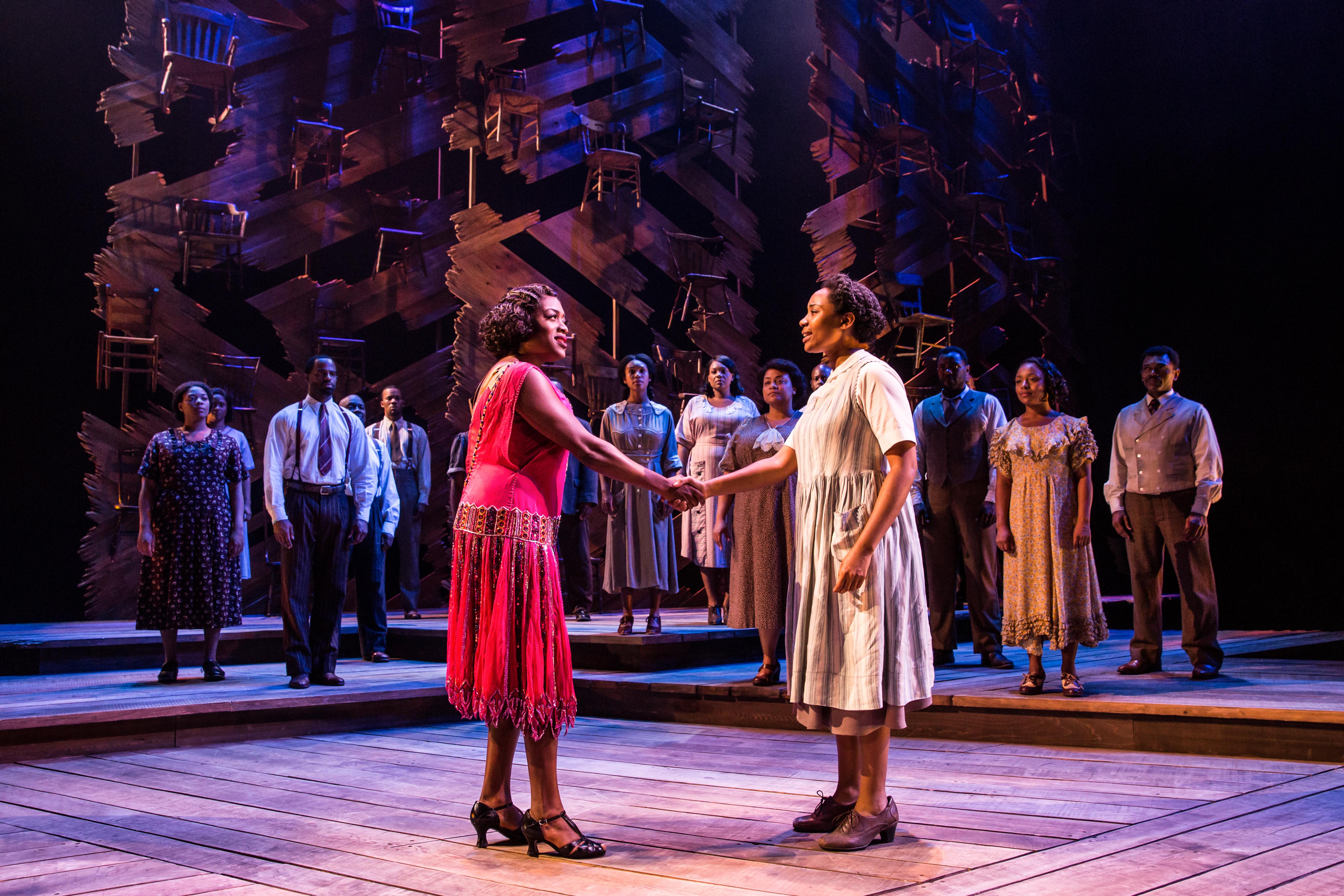This May, the North American touring cast of the revival of “The Color Purple” blows the roof of San Francisco’s SHN Orpheum Theater with its talented cast and minimalist yet poignant design choices. An adaptation of the 1982 epistolary novel of the same name by Alice Walker, “The Color Purple” follows Celie — a young Black woman in the South in the 1930s — over the course of 30 years. After being raped by her father and having the children produced by this taken away from her, her father sends her to be married to a horrific man named Albert — commonly known as Mister — who had a former lover and singer named Shug Avery. The many characters Celie encounters help her out of her situation as she grows to own a prosperous business and learn how to stand up for herself.
At first glance, what is most striking about the production is the set design by John Doyle. A minimalist, barren set of wide wooden steps lined the stage, only to be offset by a huge set of vertical panels that stretch to the ceiling — from them, chairs hang from the vertical panels and cast members pull chairs from the lower rungs to use as the set. As it is, there is really nothing else necessary to decorate the stage, as everything else is presented in the acting or through the production itself — no exposition necessary.
In “The Color Purple,” Adrianna Hicks is absolutely radiant as Celie, striking a delicate balance between the 14-year-old Celie that we are introduced to — her vibrato-free voice ringing brilliantly out in conjunction with her sister Nettie (N’Jameh Camara) as they indulge in childhood games — and the older, more jaded and more experienced Celie. Mister (Gavin Gregory) is naturally terrifying but ultimately earns the audience’s praise in “Celie’s Curse,” eventually partially redeeming himself for the terrible deeds he committed. Beginning with the first number, “Mysterious Ways,” it’s also immediately clear how incredibly refined the cast is, the talent brimming over in the first few notes of the song. With an all-Black cast, “The Color Purple” only needs to mention white people in passing, their presence a mere nuisance in the show — and the production takes Black talent and allows it to fully blossom onstage.
As we see Celie grow older, her fascination with the glamorous, sensuous Shug Avery (Carla R. Stewart) becomes clear as Celie washes Shug Avery and slowly wipes her body, yet she only truly begins her own sexual awakening after kissing Shug Avery — a moment right before the act break that virtually drew the breath away from the entire audience in an audible gasp. It’s often said that a song in a musical occurs when it cannot be said in words, and Celie and Shug Avery’s ballad “What About Love” becomes that of not just a queer love story or a Black love story, but of two people who unconditionally support and appreciate each other. The song barely even touches on explicitly romantic love, instead lingering on the closeness between the two (“I want you to be a story for me that I can believe in forever”).
From that moment, the musical production of “The Color Purple” sets itself apart in yet another way — in a single moment, it brings Celie’s love for Shug Avery without needing to indulge in scenes of physical intimacy or anything else (the book and film, for one, uses this — this isn’t to say that they are gratuitous, but the musical provides a beautiful and effective option that aligns with the set design in its striking minimalism). All throughout Act II, we then see Celie straining to contain her desire for Shug, which Shug can’t be bound to but still reciprocates in passing. It’s heartbreaking but ultimately realistic, and with Shug’s support, Celie is still able to win. Being in love with a woman doesn’t bring her down and doesn’t change who she is — loving Shug Avery is simply a fact of Celie’s life, albeit an influential one.
“The Color Purple” itself is a musical that defies definition or boxing into any genre categories — it’s an immensely moving and empowering work that doesn’t let its weighty themes drag the narrative down into a pit where humor can’t reach out. Sofia’s (Carrie Compere) famous “Hell No!” number, as she tells Celie that she cannot allow her any man to beat her or push her around, duly earned its place as one of the most emotionally intense numbers I’ve ever heard. The touring production of “The Color Purple” doesn’t use humor as a device to downplay its emotional and sociopolitical beats — rather, it keeps the audience engaged and brings out Celie’s moments of triumph as something deserving to be celebrated.
“The Color Purple” rises to the top as a mind-blowing display of Black love, appreciation, talent, truth, struggle and success. If you have the chance, go see “The Color Purple” at the Orpheum before it closes.
“The Color Purple” plays at the SHN Orpheum Theater in San Francisco until May 27.
Contact Olivia Popp at oliviapopp ‘at’ stanford.edu.
